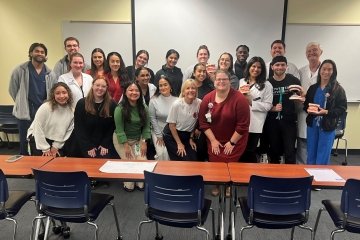Falls Prevention: The Vestibular System and Balance
Many elderly people fall because they lose their balance. Learn how this happens and steps that can be taken to help prevent the higher risk of falling as we get older.

Many people fall because they lose their balance. The ability to maintain balance results from a complex interaction of four major systems and depends on information received by the brain from the eyes, muscles and joints, and vestibular system. Disruption of just one of these factors can lead to balance problems and a higher risk of falling.
The vestibular system is one of the internal components that provides input from the inner ear. This system works to maintain the center of gravity along with sensory information from the eyes, proprioceptors (touch or pressure receptors) from the muscles and tendons, coordination of sensory input and motor output through the neurological system, and muscular strength. These components work together in healthy individuals to help maintain or regain balance; to know which way is up; to know in what direction and how fast you are moving; and to make posture adjustments when walking on uneven surfaces or if losing your balance.
The vestibular system is located on the inside of each of the ears and is about the size of a thumbnail. The vestibular system includes the parts of the inner ear and brain that process the sensory information involved with controlling balance and eye movements. Sensory information about motion, equilibrium, and spatial orientation is provided by the parts of the vestibular system known as the utricle and saccule — which detect gravity, vertical orientation, and linear movement — and three semicircular canals, which are filled with a fluid called endolymph and detect rotational movement. The canals are oriented in the three spatial planes: left/right, front/back, and up/down. As you move, the vestibular system helps you know where you are in space and how to maintain your position in it.
Dizziness is the most common symptom reported when a patient is having a problem with the vestibular system. Dizziness is abnormal and is not a typical part of aging. Dizziness is also a very subjective term, which can make it difficult to identify exactly what is happening with the body. Using the following more specific terms to describe the dizziness can be helpful in diagnosing the underlying cause and subsequent treatment.
- Vertigo is the illusion of movement—a specific sensation of spinning or a feeling that the room is spinning.
- Presyncope is the perception that one is going to faint.
- Syncope is fainting.
- Disequilibrium is the sensation of losing one’s balance without vertigo or presyncope.
- Nonspecific lightheadedness is a vague sensation not characterized by the other three categories.
It is important to see a healthcare professional with vestibular training to help determine the cause of your symptoms. Physical therapists look at both vestibular and nonvestibular causes of imbalance or dizziness and do tests and measures to determine which system is impaired and how to help correct it.
There are multiple causes for vestibular disorders, but two of the most common causes are BPPV and hypofunction.
BPPV stands for Benign Paroxysmal Positional Vertigo, which occurs when the otoconia (also called rocks, marbles, or crystals) that are within the utricle lose their correct position, causing nystagmus—an involuntary movement of eyes with the illusion of movement or sensation of spinning. This usually happens with changes in head position and usually lasts less than one minute. The treatment involves specific movements of the head called the canalith repositioning maneuver, also referred to as the Epley maneuver. This procedure helps put the crystals within the inner ear back into place, usually in one to three visits. This treatment corrects BPPV in more than 90% of cases.
When the vestibular system is not working properly due to injury, disease, or “weakness,” it is referred to as vestibular hypofunction. This is usually described more as disequilibrium, which is the sensation of losing one’s balance without vertigo or presyncope and which can cause unsteadiness with standing or walking. Vestibular hypofunction can be corrected much like a weak muscle through Vestibular Rehabilitation Therapy (VRT). Vestibular therapists are specially trained to provide specific exercises that retrain the brain to recognize and process signals from the vestibular system. VRT is most effective when practiced regularly. Individual home-based exercises will be assigned by a vestibular therapist based on symptoms and goals, to help continue vestibular rehabilitation therapy at home.
Treatment for vestibular disorders will vary greatly from person to person, depending on the type and severity of the diagnosis and symptoms. The important thing to remember is that there are ways to prevent or reduce the risk of falling. Regaining and maintaining balance is a skill that can be improved with specific exercises. If you are experiencing dizziness, see a healthcare professional to assess your symptoms and develop a treatment plan.
For more information and resources about falls and prevention, visit the National Council on Aging website.
The information contained in this article is not intended to be a substitute for professional medical advice, diagnosis, care, or treatment. Always consult a qualified healthcare provider for questions regarding any possible medical condition.
To schedule an appointment at the Midwestern University Clinics, call 623-537-6000 in Glendale, Arizona or 630-743-4500 in Downers Grove, Illinois.
Celeste Delap, D.P.T., PT, GCS, Physical Therapy Program.



